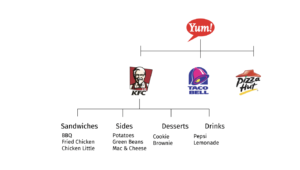
The Four Primary Components of Product Marketing
Product marketers are indispensable to the success of a product company. They’re a rare blend of sales, marketing, communications, product team, and subject-matter expertise. They articulate your product’s purpose and play a critical role in scaling that unique positioning across your team.
But… what do product marketers do?
Product marketing is an interconnected web of many moving parts, but in this post I’ll walk you through four distinct areas of that web and why they matter: Product Brand Strategy, Hierarchy, Packaging, and Positioning. And to simplify product marketing, I’ll use something we’re all familiar with: Fast food.
Product Brand Strategy
Goals
- Make it clear, efficient, and easy for the world to understand your unique product offerings.
- Create a consistent, replicable structure for making decisions and applying brand, as you scale your brand and add product lines.
Brand strategy is what connects your product to the larger brand and organization.
A product marketer needs to be the bridge between company strategy and your product.
In large companies, the marketing team is often responsible for overall corporate brand strategy. But when it comes to products, a product marketer needs to be the bridge between company strategy and your product.
This establishes the framework and strategy for how you’ll apply brand and visual assets to your company’s distinct products. For example, Yum! has a very clear brand hierarchy. They own KFC, Taco Bell, and Pizza Hut. These are three distinct product brands, with three distinct offerings, audiences, and visual treatments.

The Yum! brand hierarchy includes three distinct fast food brands. They stand out by making distinct decisions about their visual language and what kind of food they offer (the product).
Like Yum! brands, a company may have very different digital products and features with distinct brand strategies, or sometimes companies just have one branded product with stylized modules.
While there are a lot of considerations that influence how to establish your brand strategy, the most important thing you can do is to have one. How are you making decisions regarding visual identity, name, voice, consistency, and personality? Are you perceived in a way that resonates with your target audience?
Not all companies need a complex brand strategy, but all companies need something. It’ll save you time and money in the long run to establish some structure and intentionality early on, so you don’t have to fix it later. Brands are living, breathing aspects of your business. Embrace that and use it to stay relevant with your audience.
Product Hierarchy
Goals
- Organize modules and features into a framework that is meaningful, internally and externally.
- Establish a shared language that guides product growth, eases the sales process, and drives a positive customer experience.
When you establish a product hierarchy, you are creating a framework for organizing all of your modules and features within a single product.
Think about KFC’s food offerings: they can be organized into different modules such as sandwiches, sides, desserts, and drinks. This way, the features (or in this case, food offerings) have a clear home in their proper category; a cookie is a dessert feature. This allows the internal team, prospects, and customers to easily understand an offering because they know where it fits.
A hierarchy helps prioritize and provide options about how to explain and sell your product at various stages.
As people get to know your digital product, it’s important not to overwhelm them with details. To point back to the KFC example, sometimes knowing that the restaurant offers sandwiches, sides, desserts, and drinks is enough for most buyers to make an initial decision to go to the restaurant. After they’ve arrived, you can provide more detail. Buyers are the same way. Too much information all at once is overwhelming and ineffective.
A hierarchy helps prioritize and provide options about how to explain and sell your product at various stages in the buyer lifecycle, all while helping support a variety of functions across your organization, too.
Product Packaging
Goals
- Group features in a way that will appeal to buyers.
- Help your buyers quickly understand what they can buy and what they will get.
Effective packaging helps a buyer easily self-select and identify the right offering to buy.
In the KFC example, a Value Meal No. 2 package might include a Chicken Little sandwich, green beans, a cookie, and lemonade. Customers often make different buying decisions, when they see the features packaged together, than they would if they picked them à la carte. It also makes the transaction much easier. The last time I bought a car, I didn’t want to think about every single feature (like how big the windshield wiper fluid tank is)… just a few that were important to me (hello, heated seats!).
With a digital product, there’s a science to how you create compelling packages for your buyers. Your goal is to reduce friction in the buying process and make it clear and easy to buy. There’s a lot of work that goes into defining the right value metric for your company; It could be features, usage volume, or something totally unique to your industry. What’s important is that you define the value metric, and build your packaging framework to support it.
Packaging doesn’t always have to be publicly facing, either. Sometimes it’s used to easily frame up your offerings during the sales process (this is especially true when working with large, complex deals), but packaging helps have an easier conversation.
In the end, successful packaging collects the most meaningful features in order to compel prospects to buy. Product marketers have to be able to package features in a way that not only makes sense to potential buyers but also caters to what they value.
Product Positioning
Goals
- Connect the value of your product with your target audience.
- Enable your product to stand out in the market against competitors.
- Serve as a framework to support consistent messaging across all marketing channels.
Positioning is one of the most important fundamentals to get right with your digital product, because it explains how you solve your audience’s pain points and the benefits they gain from using your product. It identifies the spot you claim in the market, makes your differentiators clear, and creates a shared language around why your product matters.
Positioning identifies the spot you claim in the market.
The positioning of a product will depend entirely on its audience. Think about it: a commercial for KFC is completely different than one for Taco Bell. KFC appeals more to families and groups, while Taco Bell has a more individual focus. For Taco Bell, the audience is also predominantly younger, single customers who are accustomed to staying out late. Taco Bell’s messaging makes it clear that they serve fast, inexpensive food late into the night. By deciding this positioning from the beginning, the whole company is aligned on how to talk about the company and its products.
Summary
Whether in-house or outsourced, product marketing is a critical role to product organizations. Product marketers serve as connective tissue between product, sales, and marketing. They’re translators and amplifiers across all functions in your organization.
At the heart of it, product marketers help prospects and customers understand the value of your product, keep your team on the same page, and make it easy to buy. This enables your product to scale and prosper.



